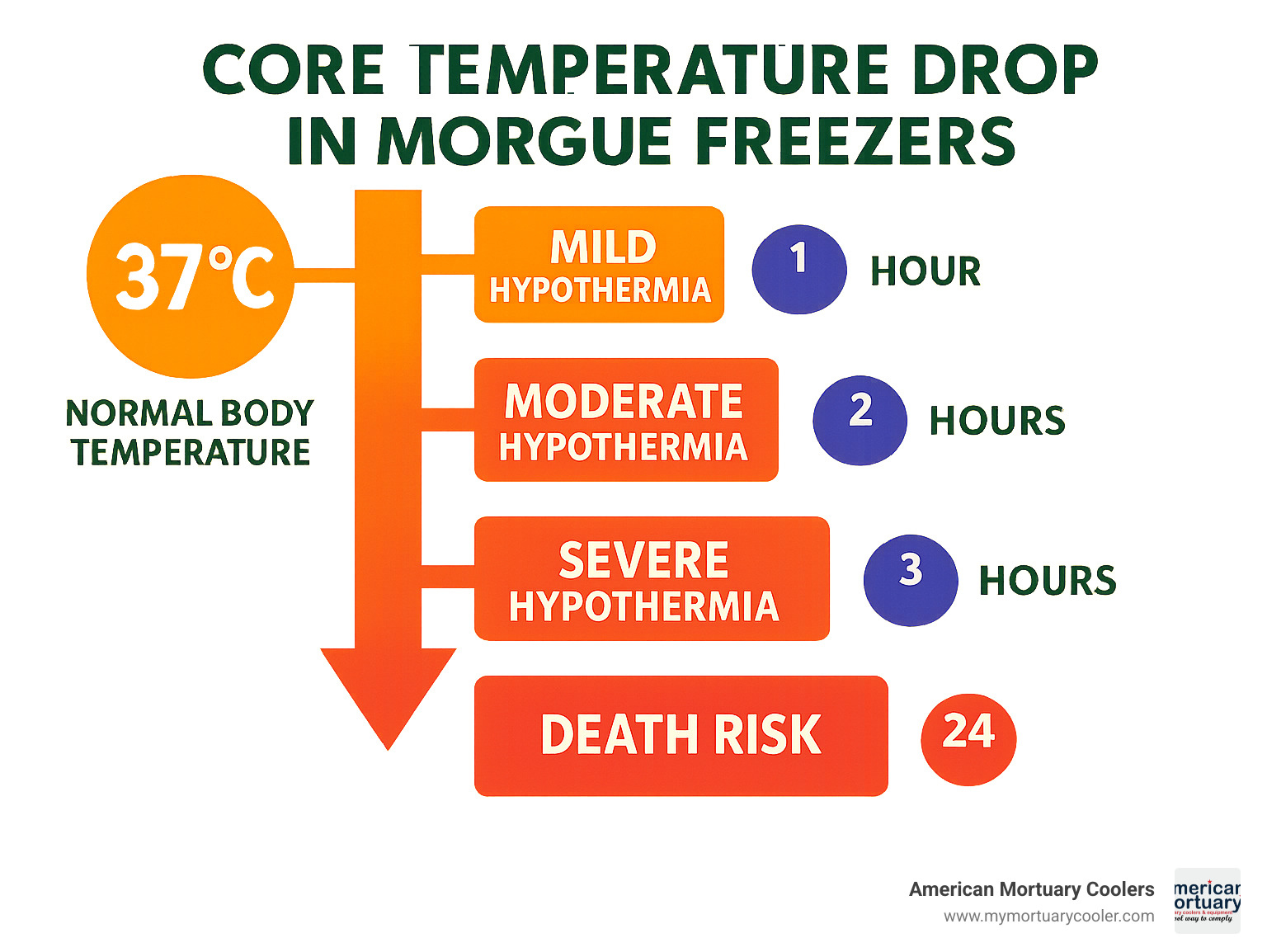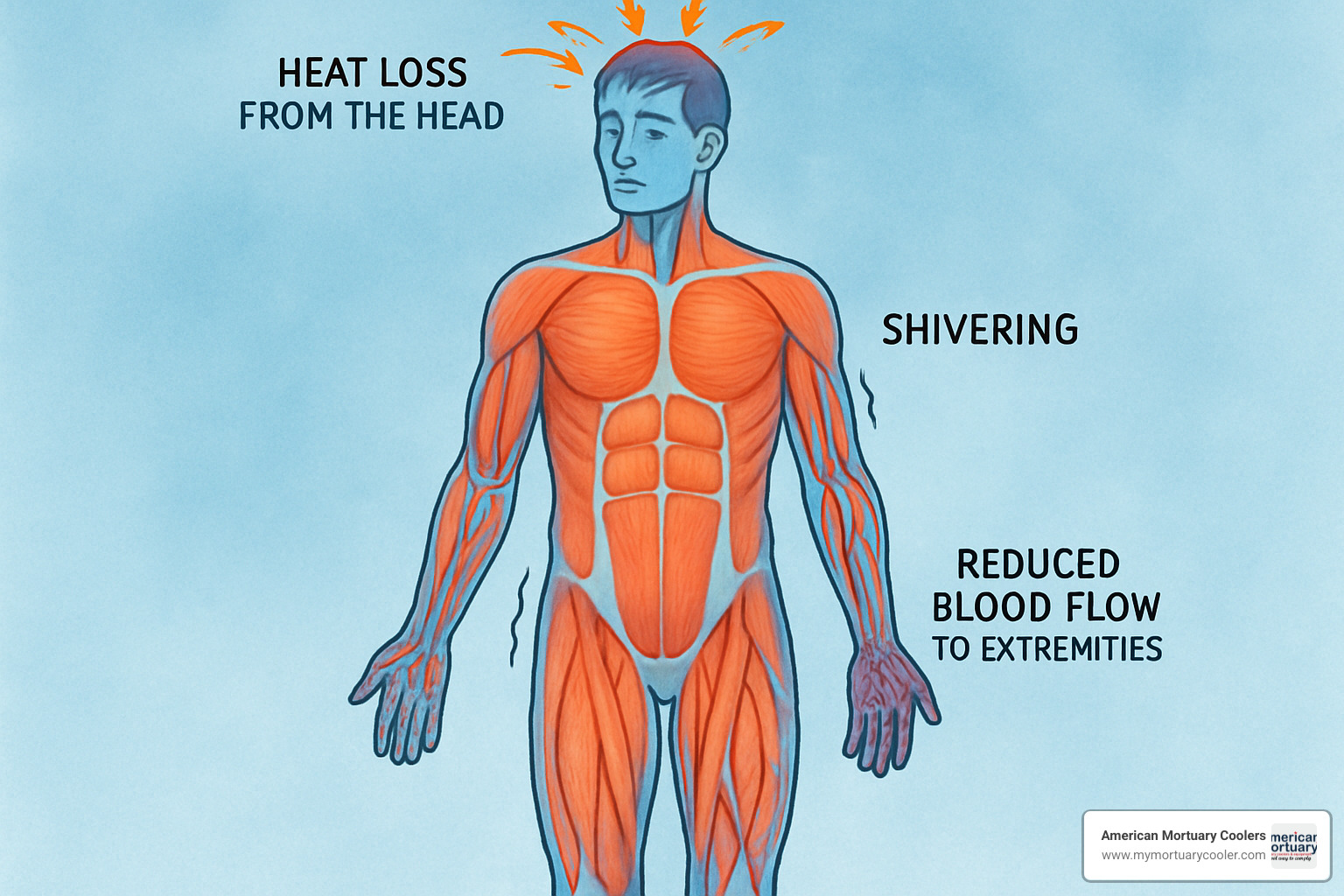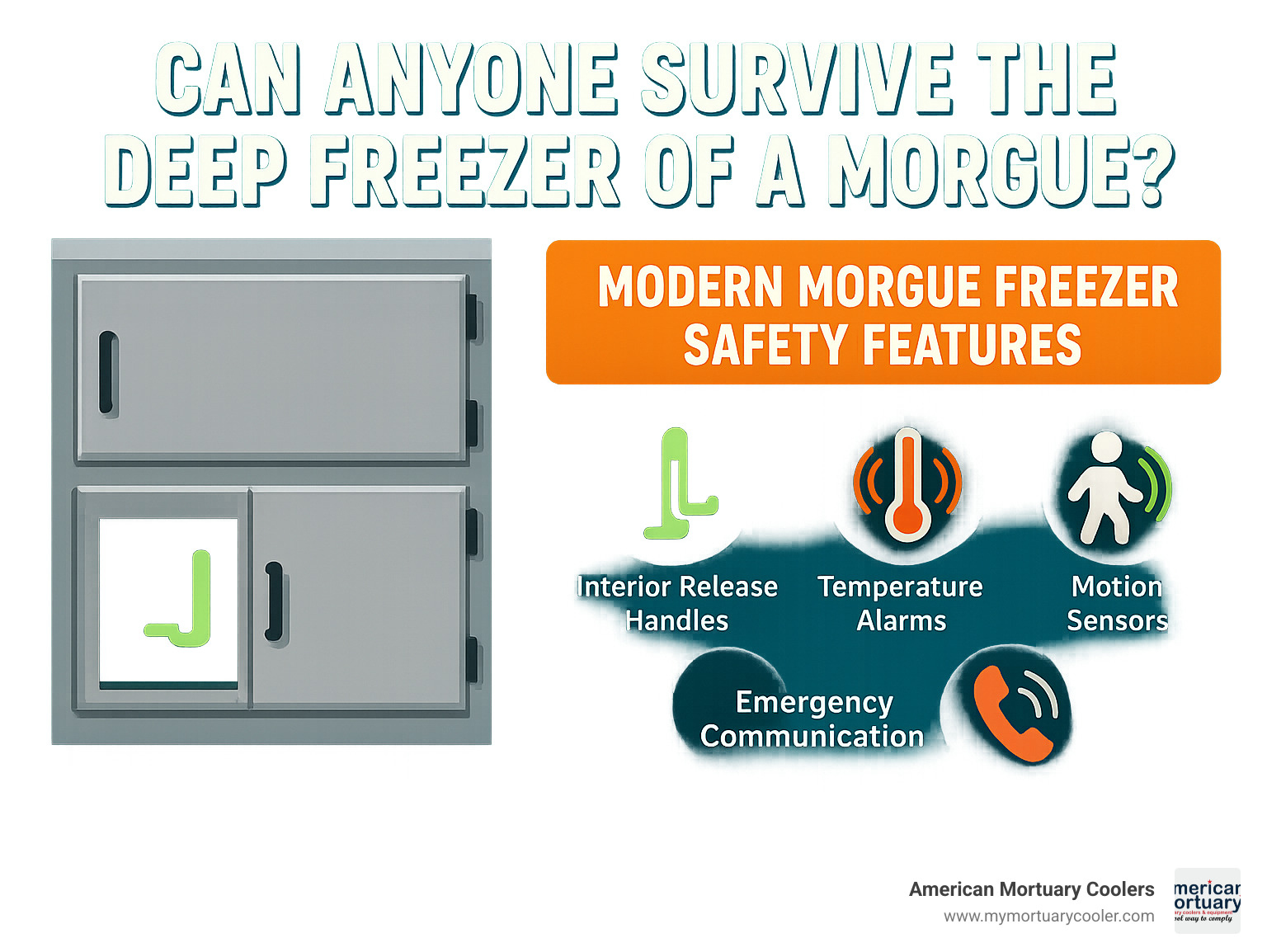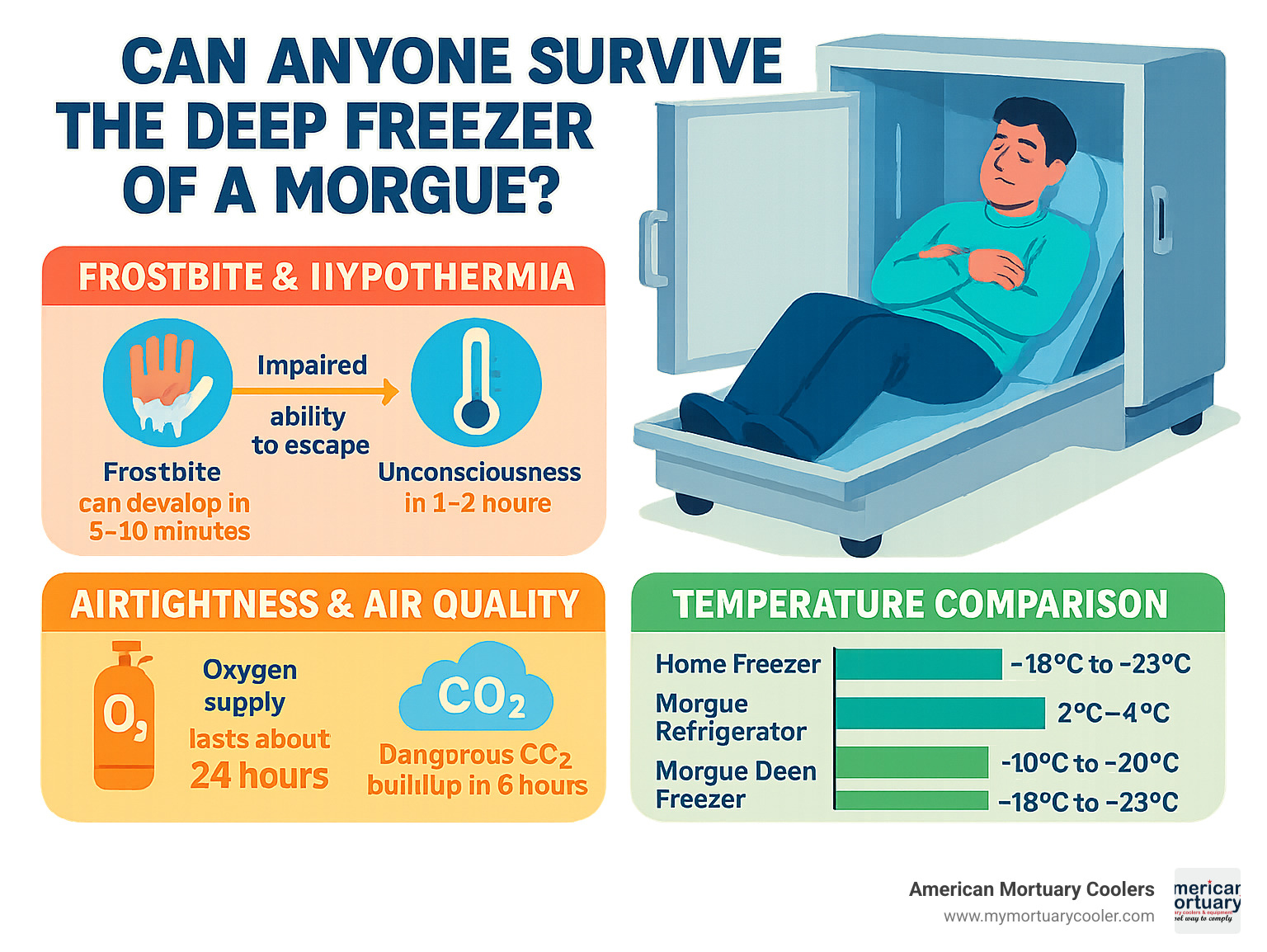
Survival in a Morgue Freezer—Myth or Reality?
Why Understanding Morgue Freezer Survival Is Critical for Safety
Can anyone survive the deep freezer of a morge is a question that haunts many people's imagination, especially after Hollywood movies and urban legends. The harsh reality is far different from fiction.
Quick Answer:
- Survival time: Minutes to a few hours maximum in true morgue freezers (-10°C to -20°C)
- Temperature impact: Core body temperature drops 1-2°C per hour
- Main dangers: Hypothermia, frostbite, and potential suffocation
- Key difference: Morgue refrigerators (2-4°C) offer better survival odds than deep freezers
- documented cases: Rare survivals only in refrigerators, not true freezers
Morgue freezers operate at temperatures between -10°C and -20°C (14°F to -4°F), which is significantly colder than most home freezers. At these extreme temperatures, the human body faces immediate and life-threatening challenges.
Hypothermia progresses in three deadly stages:
- Mild (93.2-96.8°F): Shivering, confusion
- Moderate (73.4-89.6°F): Loss of coordination, slurred speech
- Severe (Below 73.4°F): Unconsciousness, cardiac arrest
Research shows that core body temperature typically drops 1-2°C per hour in cold environments. Death usually occurs when core temperature falls below 24°C (75.2°F). In a well-publicized case from South Africa, an elderly patient mistakenly declared dead survived several hours in a mortuary refrigerator - not a deep freezer.
The key distinction matters: standard mortuary refrigerators (2-4°C) have allowed rare survivals, while true morgue freezers (-10°C to -20°C) present nearly impossible survival odds.
I'm Mortuary Cooler, a national-level mortuary cooler supplier with experience in mortuary refrigeration systems and safety protocols. Through years of working with funeral homes and medical facilities, I've seen why the question can anyone survive the deep freezer of a morge requires serious, fact-based answers rather than speculation.

Can anyone survive the deep freezer of a morge?
Bottom line: true morgue freezers run so cold (-10 °C to ‑20 °C / 14 °F to ‑4 °F) that they give a living person minutes—at most a couple of hours—before fatal hypothermia sets in.
Most headline-grabbing "morgue survivals" happened in refrigerators (2–4 °C / 35–40 °F), not freezers. That 15–20 degree gap is the difference between a narrow rescue window and near-certain death.
| Storage Type | Temperature | Likely Survival Time | Documented Survivals |
|---|---|---|---|
| Morgue Refrigerator | 2–4 °C (35–40 °F) | Up to several hours | Yes (rare) |
| Walk-in Restaurant Freezer | 0 °F to ‑10 °F | 30–120 min | Yes (few) |
| Home Freezer | 0 °F to ‑10 °F | 30–120 min | Very few |
| Morgue Deep Freezer | ‑10 °C to ‑20 °C | Minutes–1 hr | None verified |
Why a deep freezer is different
- Core temperature can fall 1–2 °C every 30 min at –15 °C. When it reaches 24 °C (75 °F) the heart often stops.
- Air is dry and still, accelerating heat loss from skin and lungs.
- Even if the unit isn’t perfectly sealed, CO₂ buildup becomes dangerous after several hours—though cold will strike first.
Factors that buy (a little) time
- Warm, layered clothing
- Higher body-fat percentage
- Calm, low-movement behavior
- Rapid findy by staff or automated alarms
Without those advantages, asking “can anyone survive the deep freezer of a morge” moves from improbable to effectively impossible within the span of a single movie length.
What Extreme Cold Does to a Living Body

When we ask can anyone survive the deep freezer of a morge, we need to understand what extreme cold actually does to a living person. The human body's response to morgue-level temperatures is swift and unforgiving.
Your body is remarkably good at maintaining its core temperature of 98.6°F under normal conditions. But in a morgue freezer operating at -10°C to -20°C, that delicate balance gets thrown into chaos within minutes.
Mild hypothermia kicks in first when your core temperature drops to 95°F. Your body immediately starts intense shivering as it desperately tries to generate heat through muscle contractions. Blood vessels in your hands, feet, and face clamp down tight, redirecting warm blood to protect your vital organs. This is when mental confusion begins creeping in, making clear thinking increasingly difficult.
As your core temperature continues falling to around 89.6°F, you enter moderate hypothermia. Here's where things get scary: the shivering that was trying to save your life suddenly stops. Your muscles become rigid and stiff. Your heart rate slows dramatically, and significant mental impairment makes it nearly impossible to help yourself.
Severe hypothermia occurs when core temperature drops below 82.4°F. Most people lose consciousness at this point. Your heart rhythm becomes dangerously erratic, breathing becomes shallow and infrequent, and cardiac arrest becomes imminent. According to scientific research on hypothermic deaths, this is when ventricular fibrillation - a fatal heart rhythm - becomes increasingly likely.
Frostbite adds another layer of danger. In morgue freezer conditions, exposed skin can develop frostbite within just 5-10 minutes. Ice crystals literally form inside your skin cells, damaging blood vessels and potentially causing permanent nerve damage or tissue death.
For more detailed information about the temperatures you'd face, check out The Complete Guide to the Temperature of Morgue Coolers.
Time-to-unconsciousness vs Time-to-death
The timeline between when you'd lose consciousness versus when death occurs varies significantly based on your body's heat loss rate and several individual factors.
Your surface area plays a huge role in how quickly you lose heat. Taller, thinner people lose heat faster than shorter, stockier individuals. This is simple physics - more surface area means more heat escaping to the cold environment.
Shivering exhaustion typically happens within 30-60 minutes in extreme cold. Once your muscles can no longer generate heat through shivering, your core temperature drops much more rapidly.
Here's what typically happens in a -15°C morgue freezer: During the first 15 minutes, you'd experience intense shivering while your mental clarity starts declining. Between 15-45 minutes, shivering peaks then begins fading as your muscles exhaust their energy reserves. By 45-90 minutes, shivering stops completely and severe confusion sets in. Unconsciousness becomes likely between 90-120 minutes, with death probable within 2-4 hours without immediate medical intervention.
Could hypothermia ever help you live longer?
This might sound strange, but controlled hypothermia is actually used in medicine to save lives. The medical principle "nobody is dead until warm and dead" reflects how cold can sometimes protect cellular function.
Therapeutic cooling is used during certain cardiac surgeries, where patients are deliberately cooled to 15-20°C to protect organs during complex procedures. The famous case of Anna Bågenholm, a Swedish radiologist, proves the protective potential of extreme cold. She survived a skiing accident with a core temperature of just 13.7°C - the lowest recorded body temperature in an accidental hypothermia survivor.
The crucial difference is that therapeutic hypothermia is controlled and monitored by medical professionals, while accidental exposure in a morgue freezer is uncontrolled and extremely dangerous.
Documented Near-Misses and Miracles
The stories that make headlines often blur the line between miracle and medical fact. When people ask can anyone survive the deep freezer of a morge, they're usually thinking of these dramatic cases. But here's what the real stories teach us.
The most famous case happened in South Africa, where an elderly patient was mistakenly declared dead and spent several hours in what news reports called a "morgue freezer." The truth? He was actually in a mortuary refrigerator running at 2-4°C, not a true deep freezer. That temperature difference saved his life.
Jean Hilliard's 1980 survival story from Minnesota captures people's imagination even today. Found "frozen solid" after six hours in -30°C weather, she made a full recovery. But Jean wasn't trapped in an enclosed freezer - she was outdoors where air could circulate and her body cooled gradually rather than experiencing sudden temperature shock.
These stories share something important: none of the documented survivals happened in true morgue deep freezers operating at -10°C to -20°C. According to scientific research on accidental survival, every verified case occurred in either mortuary refrigerators above freezing or outdoor cold environments.
The pattern becomes clear when you look at the conditions. Survival happened in mortuary refrigerators at 2-4°C where hypothermia develops over hours, not minutes. It happened outdoors where people had air to breathe and gradual cooling. It happened in walk-in coolers with better ventilation and warmer temperatures.
What makes these cases truly remarkable isn't just the survival - it's the immediate medical intervention that followed. Every survivor received expert rewarming and cardiac support within hours of findy.
For more incredible stories about survival against impossible odds, check out When Life Defies Death: The Incredible Stories of Babies in Morgue Freezers.
Why refrigerators sometimes spare lives but freezers do not
The difference between a morgue refrigerator and a deep freezer isn't just a few degrees - it's the difference between possible survival and almost certain death.
In mortuary refrigerators at 2-4°C, your body has time to adapt. Hypothermia develops slowly over several hours. Your heart keeps beating regularly. Most importantly, ice crystals don't form in your tissues because you're still above freezing.
Deep freezers at -10°C to -20°C tell a different story. Your core temperature plummets within 30-60 minutes. Ice crystals start forming in your cells, causing damage that can't be undone. Your heart rhythm becomes dangerously unstable much faster.
Think of it like the difference between wading into cold water versus jumping into an ice bath. Your body can handle gradual cooling much better than temperature shock.
Oxygen makes the difference too. Mortuary refrigerators typically aren't sealed as tightly as deep freezers. They often have better air circulation systems. This means more breathable air over longer periods - crucial when you're talking about survival times measured in hours.
Dangers, Design & Regulation: Why Getting Trapped Is Rare
Here's some good news: modern morgue equipment is specifically designed to prevent anyone from ever having to wonder can anyone survive the deep freezer of a morge in real life. The industry has learned from tragic accidents and built multiple layers of protection.
The reality is that getting trapped in a morgue freezer today is incredibly rare, thanks to strict regulations and smart design features. But let's be honest about the dangers that would exist without these safeguards.
Hypoxia tops the list of immediate threats. In a sealed environment, oxygen levels drop as you breathe, creating a suffocating situation that compounds the cold exposure. CO₂ buildup follows close behind - as carbon dioxide accumulates from your breathing, it becomes toxic at concentrations above 5%.
Of course, hypothermia remains the primary killer, with your core temperature dropping dangerously fast in sub-zero conditions. Frostbite attacks exposed skin within minutes, potentially causing permanent damage even if you survive the overall ordeal.
The funeral industry takes these dangers seriously. After 54 children were trapped and 39 died in household refrigerators between 1954-1956, Congress passed the Refrigerator Safety Act of 1956. Morgue equipment follows even stricter standards today.
OSHA requirements govern workplace safety in mortuary facilities, while NFPA standards cover fire and safety codes for funeral homes. ANSI/ASHRAE guidelines set technical standards for refrigeration equipment, ensuring every unit meets rigorous safety specifications.
Here's what really matters: interior release mechanisms are mandatory on all modern morgue coolers and freezers. Reputable manufacturers like American Mortuary Coolers build these safety features into every unit. These aren't afterthoughts - they're integral parts of the design.
Most modern morgue facilities have moved away from walk-in freezers entirely, favoring individual drawer systems for body storage. This design change alone has virtually eliminated the risk of accidental entrapment. You can learn more about this evolution in Inside Morgue Drawers: How Cadavers Are Actually Stored.
Modern safety features you should know

Today's morgue equipment includes safety features that would have seemed like science fiction just decades ago. These aren't optional extras - they're standard equipment that makes accidental entrapment nearly impossible.
Glow-in-the-dark release handles are your first line of defense. These bright, easy-to-spot handles remain visible even in complete darkness. They're positioned at standard door handle height and require minimal force to operate.
Temperature-triggered alarms serve double duty. While they primarily alert staff to equipment malfunctions that could spoil stored bodies, they also provide early warning if someone is trapped inside. These alarms connect to facility-wide systems and include both audible and visual warnings.
Motion sensors represent the newest generation of safety technology. These devices detect any movement inside storage areas and automatically trigger alarms. They're connected to facility security systems and provide immediate notification to staff, even during off-hours.
Emergency communication systems in larger units include two-way communication and panic buttons connected directly to facility alarms. Some newer models even include cellular backup communication that works even if the facility's main phone lines fail.
The bottom line? Modern morgue equipment is designed by people who understand that safety isn't negotiable. Every feature serves a purpose, and every system has a backup.
Industry regulations at a glance
The regulations governing morgue equipment aren't just bureaucratic paperwork - they're life-saving standards born from real-world tragedies and near-misses.
ANSI/ASHRAE standards cover the technical side, specifying everything from temperature control requirements to energy efficiency standards. These guidelines ensure that safety features are built into equipment from the ground up, not added as afterthoughts.
EN 17155 European standards set the bar even higher for international equipment. These standards include rigorous performance testing protocols and quality assurance requirements that many American manufacturers voluntarily adopt.
Facility inspection checklists require monthly testing of safety features, temperature monitoring verification, and alarm system functionality checks. Staff training documentation must be current, and emergency procedure reviews happen regularly.
American Mortuary Coolers builds equipment that exceeds these standards, incorporating safety features that go beyond minimum requirements. When your business involves life-and-death situations, there's no such thing as being too careful.
How to Maximize Survival if You're Locked Inside
If the unthinkable happens, seconds count. Focus on three priorities: escape, insulation, and signalling.
- Find the interior release latch. Modern units—including those built by American Mortuary Coolers—have glow-in-the-dark handles about shoulder height. Feel the door frame methodically.
- Insulate fast. Wrap yourself in any sheets, plastic body bags, or extra clothing. Stay off metal surfaces; even a thin layer of fabric slows conductive heat loss.
- Make noise & move deliberately. Bang, shout, and stomp every few minutes to trigger motion sensors or alert staff, but avoid frantic, exhausting movements.
- Breathe through your nose to warm incoming air and slow core-temperature drop.
Quick self-rescue checklist
- Locate door → pull/turn handle firmly (it may be stiff)
- No handle? Search corners for panic button or alarm cord
- Create a "nest" away from air vents; tuck knees to chest
- Repeat noise signal every 60 seconds until rescued
What NOT to do
- Don’t strip damp clothes—wet insulation is still insulation.
- Don’t lie directly on metal racks or floors.
- Don’t waste energy trying to break heavy doors; conserve heat and focus on attracting attention.
Following these steps won’t guarantee survival in a −15 °C environment, but they can stretch precious minutes into the hour you may need for rescue.
Frequently Asked Questions about Morgue Freezer Survival
Does frostbite kill before hypothermia?
No. Hypothermia incapacitates first, usually within 60–90 minutes at −15 °C. Frostbite harms fingers and toes in 5–10 minutes, but it rarely kills before your dropping core temperature does.
Are morgue freezers airtight?
They’re well-sealed for temperature control, not for life support. A typical unit holds enough oxygen for many hours, but CO₂ levels become toxic after roughly six. In practice, cold renders a person unconscious long before air quality does.
How cold is a “morgue cooler” compared to a home freezer?
Daily-use morgue refrigerators sit at 2–4 °C (35–40 °F)—closer to a kitchen fridge than a freezer. Long-term storage freezers match or slightly exceed home-freezer cold (-10 °C to ‑20 °C / 14 °F to ‑4 °F), which is why survival odds plummet in true morgue freezers.
Conclusion

So, can anyone survive the deep freezer of a morge? After diving deep into the research, examining real cases, and understanding what extreme cold does to the human body, the answer is sobering: true survival in morgue deep freezers operating at -10°C to -20°C is virtually impossible.
Here's what we've learned from the evidence. Every documented "miracle" survival happened in morgue refrigerators running at 2-4°C, not the bone-chilling deep freezers. The famous South Africa case? A refrigerator. Jean Hilliard's incredible story? She was found outdoors, not trapped in an enclosed freezer. The pattern is clear - temperature makes all the difference between a slim chance and no chance at all.
The human body simply wasn't designed to handle the extreme conditions inside a morgue freezer. Your core temperature drops 1-2°C every hour, and once it hits 24°C, cardiac arrest becomes almost inevitable. Add frostbite developing within minutes on exposed skin, and you're facing a perfect storm of physiological failure.
But here's the good news - modern morgue equipment is designed to prevent these nightmarish scenarios from ever happening. At American Mortuary Coolers, our custom units manufactured here in Tennessee come standard with interior safety releases that glow in the dark, so even in complete darkness, someone could find the escape mechanism. We also include audible alarms that sound if temperatures fluctuate and motion sensors that detect any movement inside the units.
These safety features aren't just nice-to-have extras - they're extraordinarily effective at preventing accidental entrapment. When you combine proper safety protocols with modern equipment design, the scary movie scenario of being trapped in a morgue freezer becomes almost impossible in real life.
The Hollywood myth has been thoroughly debunked. Real survival requires immediate medical intervention, controlled rewarming procedures, and frankly, exceptional luck - and even then, only in refrigerator temperatures, not true freezer conditions.
The best survival strategy is prevention. Always follow proper safety procedures around morgue equipment, never work alone near storage areas, and make sure all safety features get tested regularly. These simple steps keep everyone safe and make the question of morgue freezer survival purely academic.
We deliver our safety-equipped mortuary coolers directly across all 48 contiguous states because we believe every facility deserves equipment that protects both the deceased and the living. For more detailed information about safe storage practices, check out Frozen in Time: Understanding Morgue Freezer Storage Limits.
Respect the power of extreme cold and trust in the safety systems designed to protect you. The question can anyone survive the deep freezer of a morge serves as a powerful reminder that proper equipment and protocols save lives - and that's something we take seriously in everything we build.




